Friday, April 17, 2015
Finally doing some Shepardson!
Ever since I read Shepardson, I've been thinking about doing some real but non-serious science on the subject of plants and static charges. Before the year-long courseware project I ordered some parts from Jameco, thinking that a physical project would be a good balance for the mental strain of coding. This balancing act had worked nicely on previous iterations of courseware. Didn't work this time; I'm older, the coding was intrinsically harder and heavier, and the only balance I needed was sleep, which I didn't get nearly enough of. Still catching up.
After the coding was done in late Feb I picked up Shepardson again with the notion of using it as a re-introduction to electronics, ultimately returning to ham radio.
This online article shows a super-simple negative charge detector or electrometer. Basically a Jfet in series with a battery and an LED. I soldered it up, but it didn't seem to work; also, I really wanted more than a binary indicator. I wanted an analog meter and a sensitivity control.
As part of setting up an electronics workspace, I cleaned out a drawer that had been gathering computer junk like RS-232 cables, floppy drives, and obsolete mice for 25 years. At the bottom of the drawer was a completely forgotten little VOM. Must have bought it in 1990 and never used it.
Well, good. This will let me test the basic charge-detector principle before I buy more parts that might not be useful. So I soldered wires onto the three leads of a Jfet, then poked the source into the neg jack of VOM and the drain into the pos jack. Turned the switch to Ohms, put my hand near the gate lead, and the needle jumped! So the principle does work after all...
But wait! Serendipity calls! This isn't just a proof of concept, this is exactly the circuit I want! Sensitivity pot, analog meter, battery. No need to buy more parts.
I stuffed the Jfet inside the case, soldered the source and drain wires internally to the VOM's terminals, and brought the gate wire out to an antenna from a dead transistor radio. Now the VOM's range switch turns the detector on, and the ohms adjust pot is the sensitivity adjuster. The VOM is no longer usable for its original purpose, but since I never used it for its original purpose this is not a loss.
Effective ckt looks like this:
 = = = = =
Some initial pictures:
Near the computer:
= = = = =
Some initial pictures:
Near the computer:
 A little farther from the computer:
A little farther from the computer:
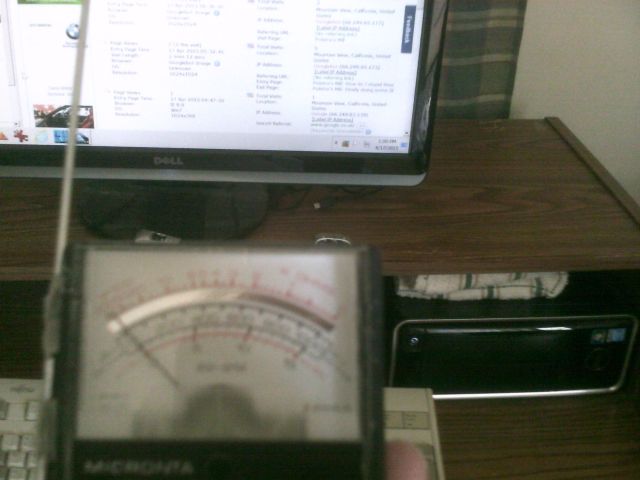 Left side of living room. This house is packed with 60 cycle hum, so this is probably more of a
signal-rectification effect than a static effect. The middle of the room seems to be 'colder' than the walls.
Left side of living room. This house is packed with 60 cycle hum, so this is probably more of a
signal-rectification effect than a static effect. The middle of the room seems to be 'colder' than the walls.
 To prove that it's not solely picking up 60: About a foot from a pile of plastic trash bags:
To prove that it's not solely picking up 60: About a foot from a pile of plastic trash bags:
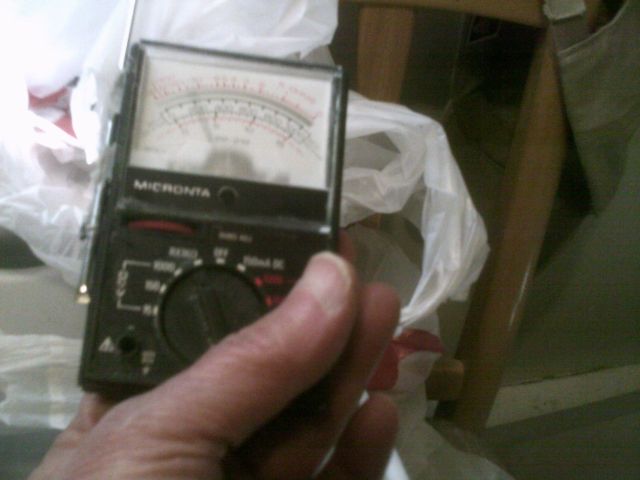 And then an inch from the bags:
And then an inch from the bags:
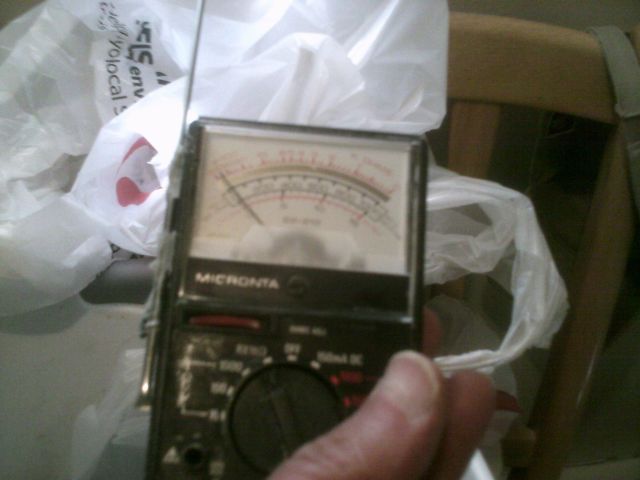 Okay, now let's get closer to Shepardson. Outside is less contaminated by 60, but it's also sunny, which means my crappy camera and non-existent camera skills get in the way. You can almost see where the needle is on the first two pics, and I accidentally got a usable picture on the third.
Far from a dandelion:
Okay, now let's get closer to Shepardson. Outside is less contaminated by 60, but it's also sunny, which means my crappy camera and non-existent camera skills get in the way. You can almost see where the needle is on the first two pics, and I accidentally got a usable picture on the third.
Far from a dandelion:
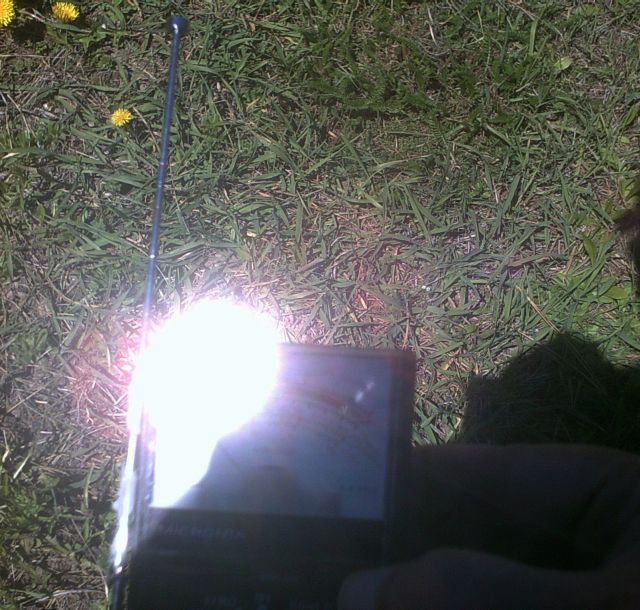 About 6 inches from dandelion:
About 6 inches from dandelion:
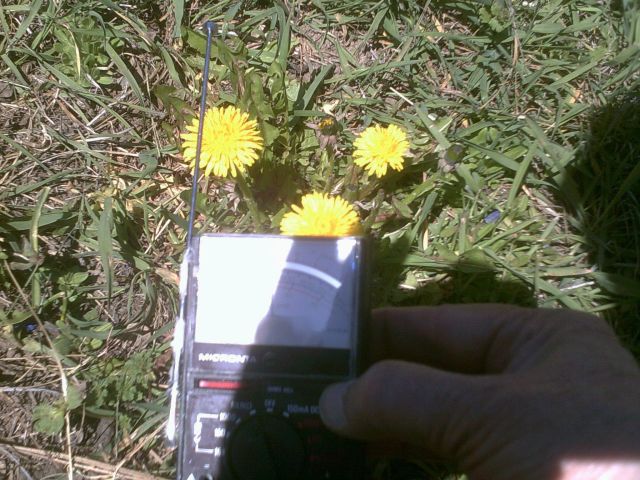 Touching the dandelion:
Touching the dandelion:
 Yay! Science, sort of!
Note that I have NOT added the 'Metrology' tag to this entry, because this crude gadget is wildly uncalibrated.
More readings here.
Yay! Science, sort of!
Note that I have NOT added the 'Metrology' tag to this entry, because this crude gadget is wildly uncalibrated.
More readings here.
 = = = = =
Some initial pictures:
Near the computer:
= = = = =
Some initial pictures:
Near the computer:
 A little farther from the computer:
A little farther from the computer:
 Left side of living room. This house is packed with 60 cycle hum, so this is probably more of a
signal-rectification effect than a static effect. The middle of the room seems to be 'colder' than the walls.
Left side of living room. This house is packed with 60 cycle hum, so this is probably more of a
signal-rectification effect than a static effect. The middle of the room seems to be 'colder' than the walls.
 To prove that it's not solely picking up 60: About a foot from a pile of plastic trash bags:
To prove that it's not solely picking up 60: About a foot from a pile of plastic trash bags:
 And then an inch from the bags:
And then an inch from the bags:
 Okay, now let's get closer to Shepardson. Outside is less contaminated by 60, but it's also sunny, which means my crappy camera and non-existent camera skills get in the way. You can almost see where the needle is on the first two pics, and I accidentally got a usable picture on the third.
Far from a dandelion:
Okay, now let's get closer to Shepardson. Outside is less contaminated by 60, but it's also sunny, which means my crappy camera and non-existent camera skills get in the way. You can almost see where the needle is on the first two pics, and I accidentally got a usable picture on the third.
Far from a dandelion:
 About 6 inches from dandelion:
About 6 inches from dandelion:
 Touching the dandelion:
Touching the dandelion:
 Yay! Science, sort of!
Note that I have NOT added the 'Metrology' tag to this entry, because this crude gadget is wildly uncalibrated.
More readings here.
Yay! Science, sort of!
Note that I have NOT added the 'Metrology' tag to this entry, because this crude gadget is wildly uncalibrated.
More readings here.Labels: bee, coot-proofing, Grand Blueprint, new toy
